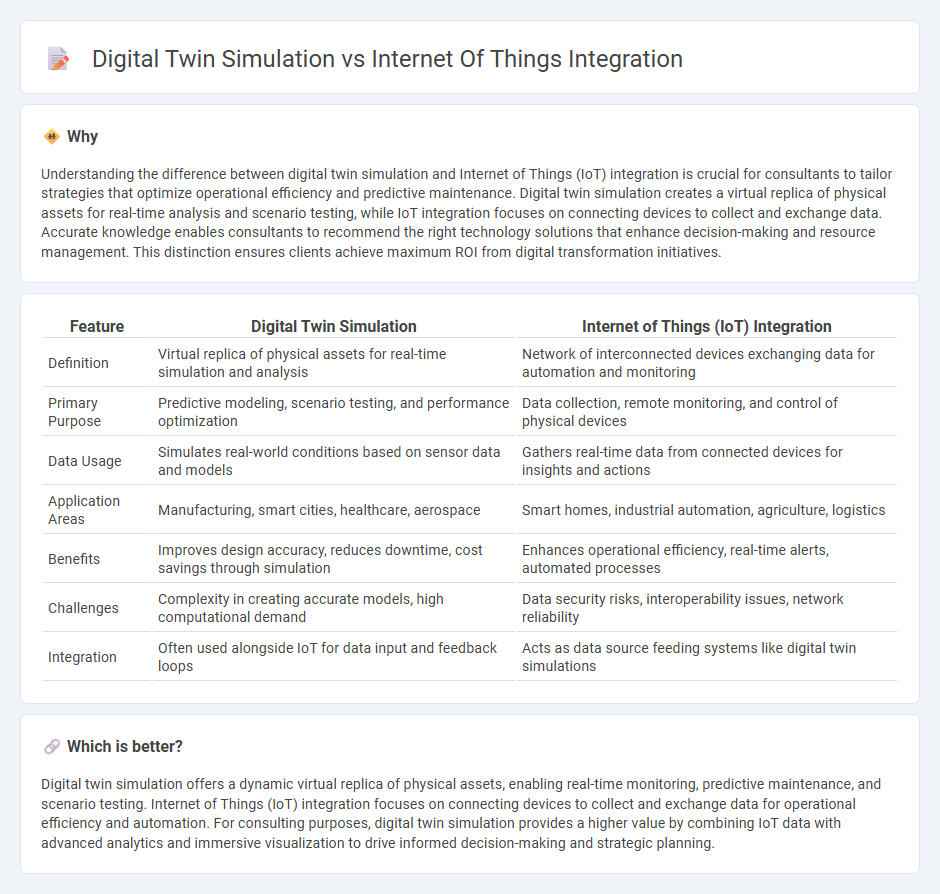
Digital twin simulation creates precise virtual replicas of physical assets to predict performance and optimize operations, whereas Internet of Things (IoT) integration focuses on connecting devices and collecting real-time data for enhanced monitoring and control. Combining these technologies enables businesses to leverage comprehensive insights, improve decision-making, and drive operational efficiency. Discover how consulting services can tailor digital twin and IoT strategies to your organization's unique needs.
Why it is important
Understanding the difference between digital twin simulation and Internet of Things (IoT) integration is crucial for consultants to tailor strategies that optimize operational efficiency and predictive maintenance. Digital twin simulation creates a virtual replica of physical assets for real-time analysis and scenario testing, while IoT integration focuses on connecting devices to collect and exchange data. Accurate knowledge enables consultants to recommend the right technology solutions that enhance decision-making and resource management. This distinction ensures clients achieve maximum ROI from digital transformation initiatives.
Comparison Table
| Feature | Digital Twin Simulation | Internet of Things (IoT) Integration |
|---|---|---|
| Definition | Virtual replica of physical assets for real-time simulation and analysis | Network of interconnected devices exchanging data for automation and monitoring |
| Primary Purpose | Predictive modeling, scenario testing, and performance optimization | Data collection, remote monitoring, and control of physical devices |
| Data Usage | Simulates real-world conditions based on sensor data and models | Gathers real-time data from connected devices for insights and actions |
| Application Areas | Manufacturing, smart cities, healthcare, aerospace | Smart homes, industrial automation, agriculture, logistics |
| Benefits | Improves design accuracy, reduces downtime, cost savings through simulation | Enhances operational efficiency, real-time alerts, automated processes |
| Challenges | Complexity in creating accurate models, high computational demand | Data security risks, interoperability issues, network reliability |
| Integration | Often used alongside IoT for data input and feedback loops | Acts as data source feeding systems like digital twin simulations |
Which is better?
Digital twin simulation offers a dynamic virtual replica of physical assets, enabling real-time monitoring, predictive maintenance, and scenario testing. Internet of Things (IoT) integration focuses on connecting devices to collect and exchange data for operational efficiency and automation. For consulting purposes, digital twin simulation provides a higher value by combining IoT data with advanced analytics and immersive visualization to drive informed decision-making and strategic planning.
Connection
Digital twin simulation leverages real-time data from IoT sensors to create accurate virtual models of physical assets, enabling predictive maintenance and operational optimization. The integration of IoT enhances digital twin capabilities by continuously feeding live data streams, improving simulation accuracy and decision-making processes. Consulting services help organizations implement these technologies strategically to increase efficiency, reduce costs, and drive innovation.
Key Terms
Sensor Data Connectivity
Internet of Things (IoT) integration involves connecting sensor data from various devices to enable real-time monitoring and control, enhancing operational efficiency across industries. Digital twin simulation uses this sensor data to create virtual models of physical assets, allowing predictive analysis and scenario testing without interrupting actual processes. Explore how combining IoT connectivity with digital twin technology transforms data-driven decision-making and operational strategies.
Real-Time Virtual Modeling
Real-time virtual modeling enhances Internet of Things (IoT) integration by creating dynamic digital twins that mirror physical assets with precise sensor data and operational parameters. This approach enables continuous monitoring, predictive maintenance, and optimized performance in industrial and smart-city applications. Explore how real-time digital twin simulations revolutionize IoT ecosystems for superior decision-making and efficiency.
Predictive Analytics
Internet of Things (IoT) integration enables real-time data collection from interconnected devices, enhancing predictive analytics by providing continuous, high-volume sensor data for accurate forecasting. Digital twin simulation uses virtual models mirrored from physical systems to analyze performance and predict outcomes through scenario testing and data synthesis. Explore how combining IoT integration and digital twin simulation advances predictive analytics in smart environments.
Source and External Links
IoT Device Integration - Improve Efficiency & Connectivity - IoT integration connects devices with applications, databases, and cloud systems to enable seamless data exchange and automated workflows, enhancing operations and decision-making in areas like fitness tracking, smart security, and fleet management.
What Is IoT Integration? A Guide to Overcoming Challenges - IoT integration involves linking smart devices to networks through gateways, defining business goals, selecting appropriate devices, and often using cloud-based platforms or iPaaS for efficient, secure, and scalable data exchange.
Integration with Internet of Things (IoT): Everything You Need To Know - Emerging trends in IoT integration involve AI, machine learning, 5G connectivity, and blockchain, enabling more autonomous, secure, and real-time responsive IoT systems across industries.
 dowidth.com
dowidth.com